Cross-Cultural Business: Hofstede Model and Wal-Mart's German Venture
VerifiedAdded on 2022/12/23
|17
|5021
|64
Report
AI Summary
This report delves into the complexities of business culture, focusing on the Hofstede model of national culture and its application to international business. It begins with an introduction to cross-cultural issues, the importance of cultural understanding in a globalized economy, and an overview of the Hofstede model's dimensions, including power distance, masculinity/femininity, individualism, uncertainty avoidance, and long-term orientation. The report then critiques the Hofstede model, acknowledging its limitations and presenting alternative models like Trompenaar, Schwartz, and the GLOBE project. The core of the report examines Wal-Mart's expansion into Germany, detailing the company's acquisition strategy and eventual failure. It analyzes the impact of national culture on Wal-Mart's operations, highlighting the cultural differences that led to the company's struggles, including consumer preferences, employment practices, and a lack of cultural sensitivity. The role of organizational culture in Wal-Mart's failure is also explored. The report concludes with a summary of the key findings and lessons learned from Wal-Mart's experience, emphasizing the importance of adapting to local cultures and understanding cultural dimensions for successful international business ventures.
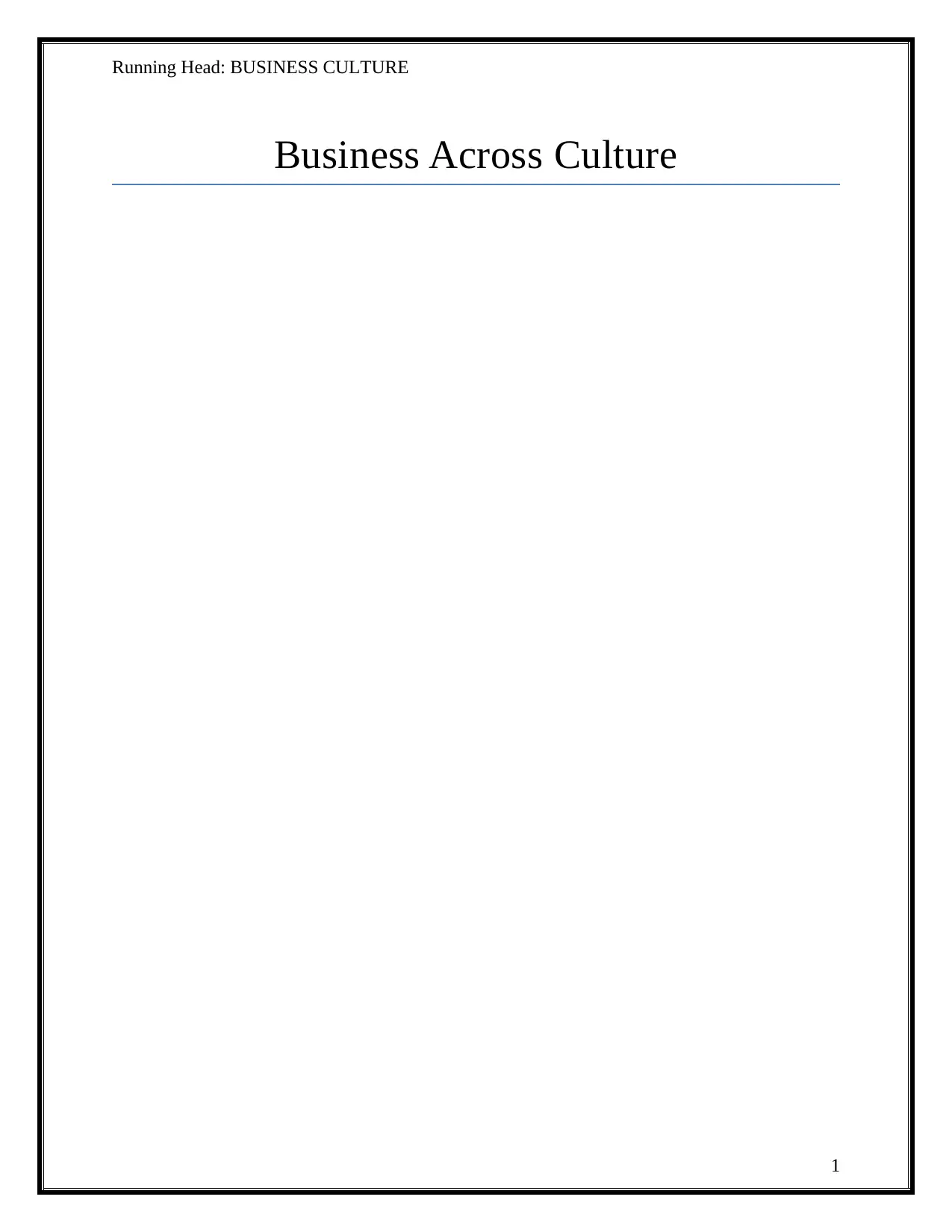
Running Head: BUSINESS CULTURE
Business Across Culture
1
Business Across Culture
1
Paraphrase This Document
Need a fresh take? Get an instant paraphrase of this document with our AI Paraphraser

Business culture
Table of Contents
Introduction......................................................................................................................................3
Section 1..........................................................................................................................................3
Hofstede model of national culture..............................................................................................3
Criticism for the model................................................................................................................6
Alternate models..........................................................................................................................6
Section 2..........................................................................................................................................6
Business development by Wal-Mart in Germany........................................................................6
Impact of national culture on activities of Wal-Mart..................................................................7
Role of organizational culture in Wal-Mart.................................................................................9
Conclusion.....................................................................................................................................12
References......................................................................................................................................13
2
Table of Contents
Introduction......................................................................................................................................3
Section 1..........................................................................................................................................3
Hofstede model of national culture..............................................................................................3
Criticism for the model................................................................................................................6
Alternate models..........................................................................................................................6
Section 2..........................................................................................................................................6
Business development by Wal-Mart in Germany........................................................................6
Impact of national culture on activities of Wal-Mart..................................................................7
Role of organizational culture in Wal-Mart.................................................................................9
Conclusion.....................................................................................................................................12
References......................................................................................................................................13
2
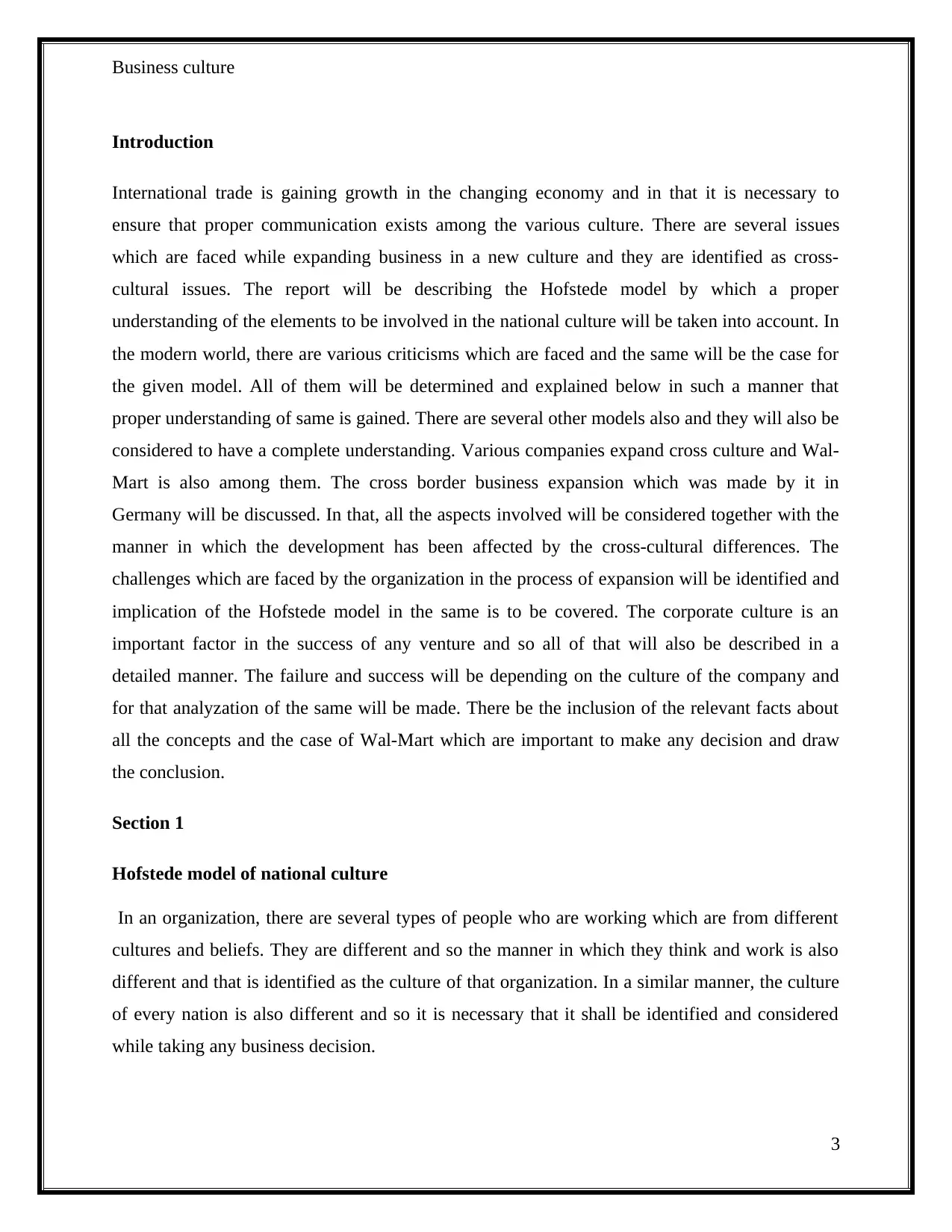
Business culture
Introduction
International trade is gaining growth in the changing economy and in that it is necessary to
ensure that proper communication exists among the various culture. There are several issues
which are faced while expanding business in a new culture and they are identified as cross-
cultural issues. The report will be describing the Hofstede model by which a proper
understanding of the elements to be involved in the national culture will be taken into account. In
the modern world, there are various criticisms which are faced and the same will be the case for
the given model. All of them will be determined and explained below in such a manner that
proper understanding of same is gained. There are several other models also and they will also be
considered to have a complete understanding. Various companies expand cross culture and Wal-
Mart is also among them. The cross border business expansion which was made by it in
Germany will be discussed. In that, all the aspects involved will be considered together with the
manner in which the development has been affected by the cross-cultural differences. The
challenges which are faced by the organization in the process of expansion will be identified and
implication of the Hofstede model in the same is to be covered. The corporate culture is an
important factor in the success of any venture and so all of that will also be described in a
detailed manner. The failure and success will be depending on the culture of the company and
for that analyzation of the same will be made. There be the inclusion of the relevant facts about
all the concepts and the case of Wal-Mart which are important to make any decision and draw
the conclusion.
Section 1
Hofstede model of national culture
In an organization, there are several types of people who are working which are from different
cultures and beliefs. They are different and so the manner in which they think and work is also
different and that is identified as the culture of that organization. In a similar manner, the culture
of every nation is also different and so it is necessary that it shall be identified and considered
while taking any business decision.
3
Introduction
International trade is gaining growth in the changing economy and in that it is necessary to
ensure that proper communication exists among the various culture. There are several issues
which are faced while expanding business in a new culture and they are identified as cross-
cultural issues. The report will be describing the Hofstede model by which a proper
understanding of the elements to be involved in the national culture will be taken into account. In
the modern world, there are various criticisms which are faced and the same will be the case for
the given model. All of them will be determined and explained below in such a manner that
proper understanding of same is gained. There are several other models also and they will also be
considered to have a complete understanding. Various companies expand cross culture and Wal-
Mart is also among them. The cross border business expansion which was made by it in
Germany will be discussed. In that, all the aspects involved will be considered together with the
manner in which the development has been affected by the cross-cultural differences. The
challenges which are faced by the organization in the process of expansion will be identified and
implication of the Hofstede model in the same is to be covered. The corporate culture is an
important factor in the success of any venture and so all of that will also be described in a
detailed manner. The failure and success will be depending on the culture of the company and
for that analyzation of the same will be made. There be the inclusion of the relevant facts about
all the concepts and the case of Wal-Mart which are important to make any decision and draw
the conclusion.
Section 1
Hofstede model of national culture
In an organization, there are several types of people who are working which are from different
cultures and beliefs. They are different and so the manner in which they think and work is also
different and that is identified as the culture of that organization. In a similar manner, the culture
of every nation is also different and so it is necessary that it shall be identified and considered
while taking any business decision.
3
⊘ This is a preview!⊘
Do you want full access?
Subscribe today to unlock all pages.

Trusted by 1+ million students worldwide
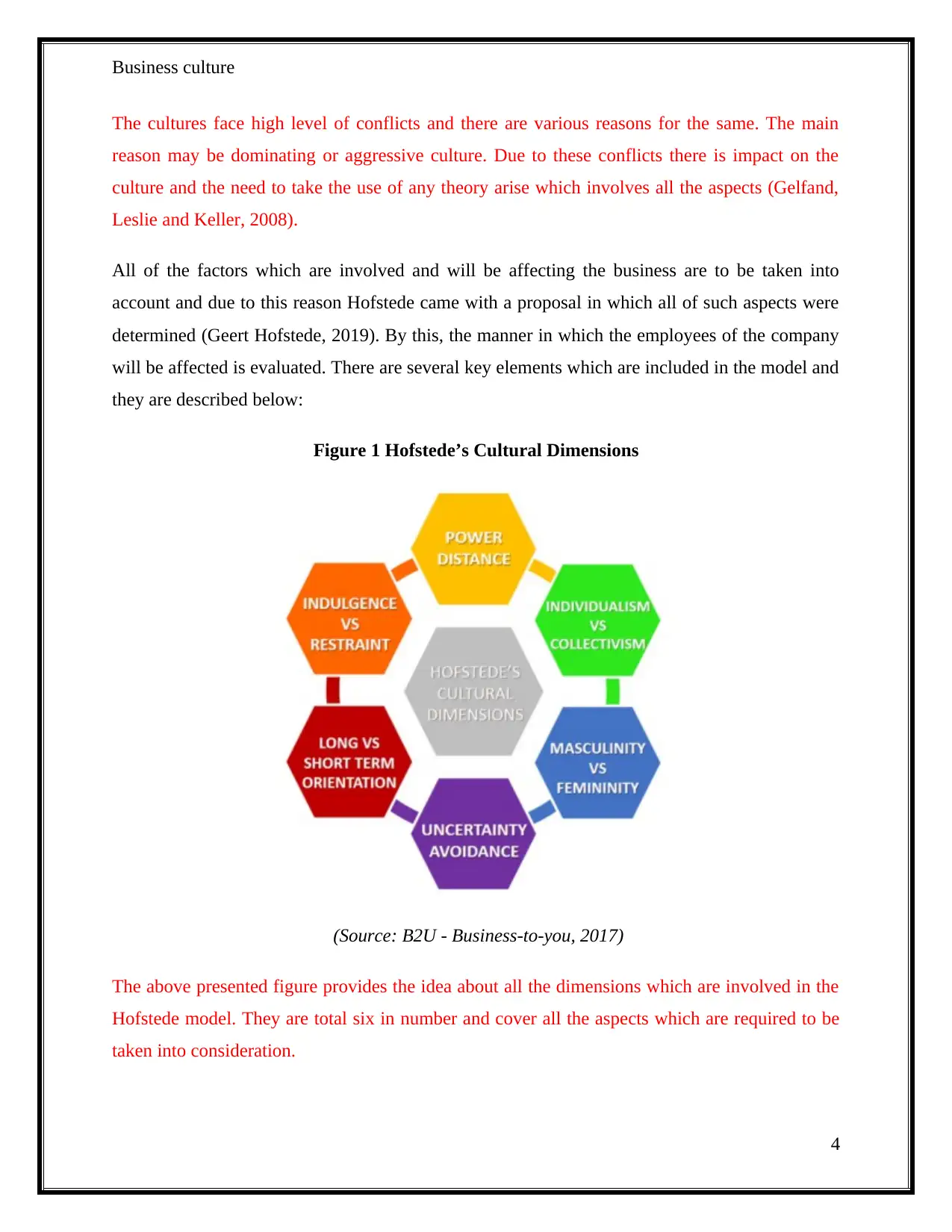
Business culture
The cultures face high level of conflicts and there are various reasons for the same. The main
reason may be dominating or aggressive culture. Due to these conflicts there is impact on the
culture and the need to take the use of any theory arise which involves all the aspects (Gelfand,
Leslie and Keller, 2008).
All of the factors which are involved and will be affecting the business are to be taken into
account and due to this reason Hofstede came with a proposal in which all of such aspects were
determined (Geert Hofstede, 2019). By this, the manner in which the employees of the company
will be affected is evaluated. There are several key elements which are included in the model and
they are described below:
Figure 1 Hofstede’s Cultural Dimensions
(Source: B2U - Business-to-you, 2017)
The above presented figure provides the idea about all the dimensions which are involved in the
Hofstede model. They are total six in number and cover all the aspects which are required to be
taken into consideration.
4
The cultures face high level of conflicts and there are various reasons for the same. The main
reason may be dominating or aggressive culture. Due to these conflicts there is impact on the
culture and the need to take the use of any theory arise which involves all the aspects (Gelfand,
Leslie and Keller, 2008).
All of the factors which are involved and will be affecting the business are to be taken into
account and due to this reason Hofstede came with a proposal in which all of such aspects were
determined (Geert Hofstede, 2019). By this, the manner in which the employees of the company
will be affected is evaluated. There are several key elements which are included in the model and
they are described below:
Figure 1 Hofstede’s Cultural Dimensions
(Source: B2U - Business-to-you, 2017)
The above presented figure provides the idea about all the dimensions which are involved in the
Hofstede model. They are total six in number and cover all the aspects which are required to be
taken into consideration.
4
Paraphrase This Document
Need a fresh take? Get an instant paraphrase of this document with our AI Paraphraser

Business culture
Power distance: In the country, the delegation of power is made among all the people and by
that the difference in the work culture arises. There are various levels in which leaders are
appointed and then other people work under them. They are required to perform the operations in
accordance with the instructions of the team lead. In some of the countries, the delegation is not
performed and so all of them will be responsible for their own tasks. The PDI express the degree
to which more powerful members in the society suppress less powerful members in a country. It
clearly explains the level of inequality present in the country.
Masculinity and Feminity: This segment of the Hofstede model explains about the ways in
which success is preferred in the society that means that more competitive countries having
heroism, material rewards to measure success are more inclined towards masculinity while the
countries believing in modesty and cooperation for growth are inclined towards Feminity. It is
considered that male members majorly dominate females and so the culture of society is affected
by that. This can be reversed also and in such case policies will be framed accordingly.
Individualism: This dimension of the model states that countries have either loosely knit or
tightly knit social framework. In loosely knit framework, people believe in managing their blood
relatives and taking care of themselves only while in tightly knit social countries, people work in
groups and live with extended families only (Hofstede Insights, 2019).
Uncertainty avoidance index: There are favorable as well as the unfavorable circumstances in
the society and all members shall be capable to deal with all of them. The tolerance level in this
respect is identified under this index which will ensure the steps to taken and the manner in
which all are to be prepared. Weak UAI activities in the country implement more relaxed and
creative practices to avoid issues in the environment and vice versa.
Long-term orientation: The nation works with the long term objectives and for that, it is
essential that better relations among all are developed. By the help of this, they will be satisfied
for longer duration and the culture will be improved. The situation in some nations is different
and they with short term motives and in that people also work for making profits in given
opportunities and not for the growth of the country. People according to this segment
differentiate the countries on the basis of their readiness for the future whereas having disbelief
in the societal changes.
5
Power distance: In the country, the delegation of power is made among all the people and by
that the difference in the work culture arises. There are various levels in which leaders are
appointed and then other people work under them. They are required to perform the operations in
accordance with the instructions of the team lead. In some of the countries, the delegation is not
performed and so all of them will be responsible for their own tasks. The PDI express the degree
to which more powerful members in the society suppress less powerful members in a country. It
clearly explains the level of inequality present in the country.
Masculinity and Feminity: This segment of the Hofstede model explains about the ways in
which success is preferred in the society that means that more competitive countries having
heroism, material rewards to measure success are more inclined towards masculinity while the
countries believing in modesty and cooperation for growth are inclined towards Feminity. It is
considered that male members majorly dominate females and so the culture of society is affected
by that. This can be reversed also and in such case policies will be framed accordingly.
Individualism: This dimension of the model states that countries have either loosely knit or
tightly knit social framework. In loosely knit framework, people believe in managing their blood
relatives and taking care of themselves only while in tightly knit social countries, people work in
groups and live with extended families only (Hofstede Insights, 2019).
Uncertainty avoidance index: There are favorable as well as the unfavorable circumstances in
the society and all members shall be capable to deal with all of them. The tolerance level in this
respect is identified under this index which will ensure the steps to taken and the manner in
which all are to be prepared. Weak UAI activities in the country implement more relaxed and
creative practices to avoid issues in the environment and vice versa.
Long-term orientation: The nation works with the long term objectives and for that, it is
essential that better relations among all are developed. By the help of this, they will be satisfied
for longer duration and the culture will be improved. The situation in some nations is different
and they with short term motives and in that people also work for making profits in given
opportunities and not for the growth of the country. People according to this segment
differentiate the countries on the basis of their readiness for the future whereas having disbelief
in the societal changes.
5
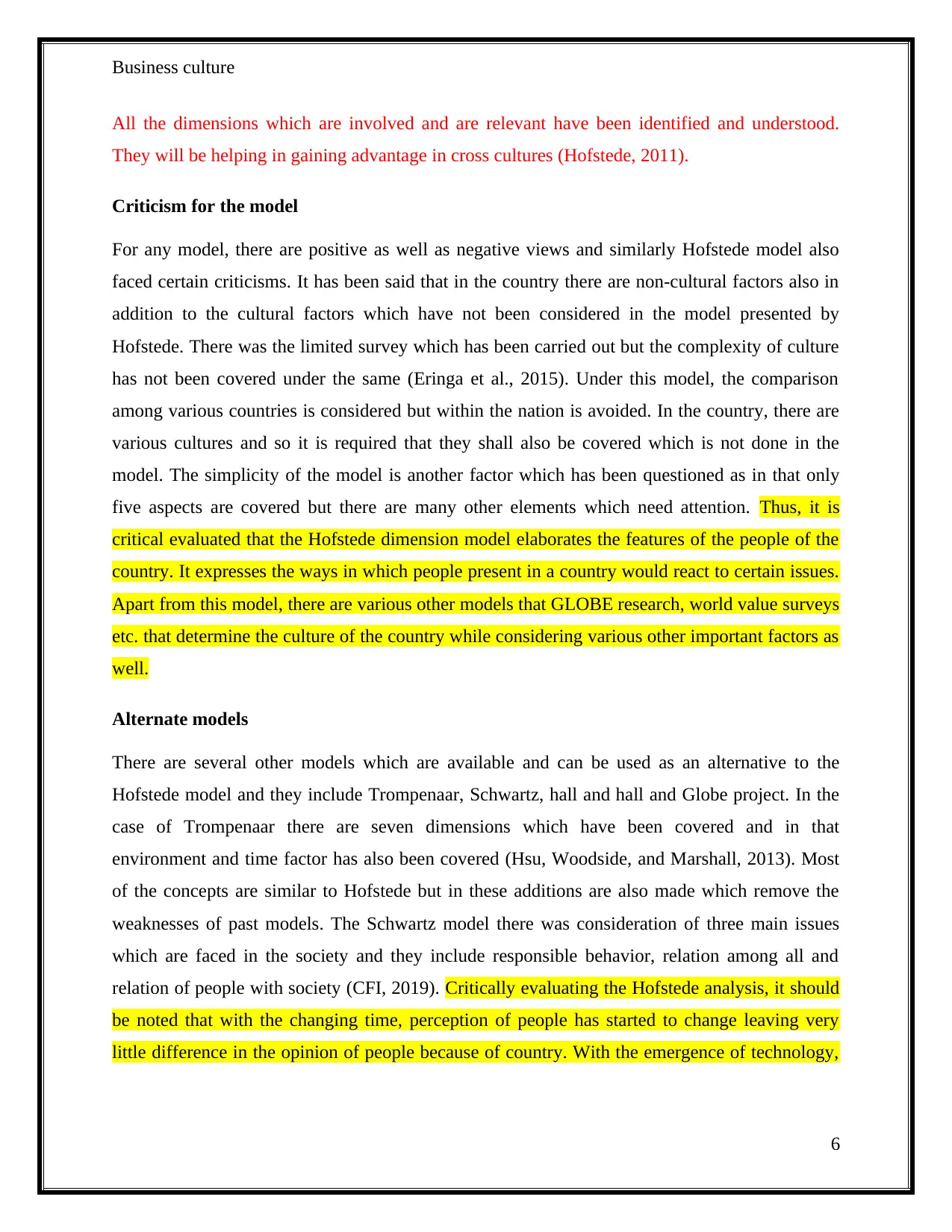
Business culture
All the dimensions which are involved and are relevant have been identified and understood.
They will be helping in gaining advantage in cross cultures (Hofstede, 2011).
Criticism for the model
For any model, there are positive as well as negative views and similarly Hofstede model also
faced certain criticisms. It has been said that in the country there are non-cultural factors also in
addition to the cultural factors which have not been considered in the model presented by
Hofstede. There was the limited survey which has been carried out but the complexity of culture
has not been covered under the same (Eringa et al., 2015). Under this model, the comparison
among various countries is considered but within the nation is avoided. In the country, there are
various cultures and so it is required that they shall also be covered which is not done in the
model. The simplicity of the model is another factor which has been questioned as in that only
five aspects are covered but there are many other elements which need attention. Thus, it is
critical evaluated that the Hofstede dimension model elaborates the features of the people of the
country. It expresses the ways in which people present in a country would react to certain issues.
Apart from this model, there are various other models that GLOBE research, world value surveys
etc. that determine the culture of the country while considering various other important factors as
well.
Alternate models
There are several other models which are available and can be used as an alternative to the
Hofstede model and they include Trompenaar, Schwartz, hall and hall and Globe project. In the
case of Trompenaar there are seven dimensions which have been covered and in that
environment and time factor has also been covered (Hsu, Woodside, and Marshall, 2013). Most
of the concepts are similar to Hofstede but in these additions are also made which remove the
weaknesses of past models. The Schwartz model there was consideration of three main issues
which are faced in the society and they include responsible behavior, relation among all and
relation of people with society (CFI, 2019). Critically evaluating the Hofstede analysis, it should
be noted that with the changing time, perception of people has started to change leaving very
little difference in the opinion of people because of country. With the emergence of technology,
6
All the dimensions which are involved and are relevant have been identified and understood.
They will be helping in gaining advantage in cross cultures (Hofstede, 2011).
Criticism for the model
For any model, there are positive as well as negative views and similarly Hofstede model also
faced certain criticisms. It has been said that in the country there are non-cultural factors also in
addition to the cultural factors which have not been considered in the model presented by
Hofstede. There was the limited survey which has been carried out but the complexity of culture
has not been covered under the same (Eringa et al., 2015). Under this model, the comparison
among various countries is considered but within the nation is avoided. In the country, there are
various cultures and so it is required that they shall also be covered which is not done in the
model. The simplicity of the model is another factor which has been questioned as in that only
five aspects are covered but there are many other elements which need attention. Thus, it is
critical evaluated that the Hofstede dimension model elaborates the features of the people of the
country. It expresses the ways in which people present in a country would react to certain issues.
Apart from this model, there are various other models that GLOBE research, world value surveys
etc. that determine the culture of the country while considering various other important factors as
well.
Alternate models
There are several other models which are available and can be used as an alternative to the
Hofstede model and they include Trompenaar, Schwartz, hall and hall and Globe project. In the
case of Trompenaar there are seven dimensions which have been covered and in that
environment and time factor has also been covered (Hsu, Woodside, and Marshall, 2013). Most
of the concepts are similar to Hofstede but in these additions are also made which remove the
weaknesses of past models. The Schwartz model there was consideration of three main issues
which are faced in the society and they include responsible behavior, relation among all and
relation of people with society (CFI, 2019). Critically evaluating the Hofstede analysis, it should
be noted that with the changing time, perception of people has started to change leaving very
little difference in the opinion of people because of country. With the emergence of technology,
6
⊘ This is a preview!⊘
Do you want full access?
Subscribe today to unlock all pages.

Trusted by 1+ million students worldwide
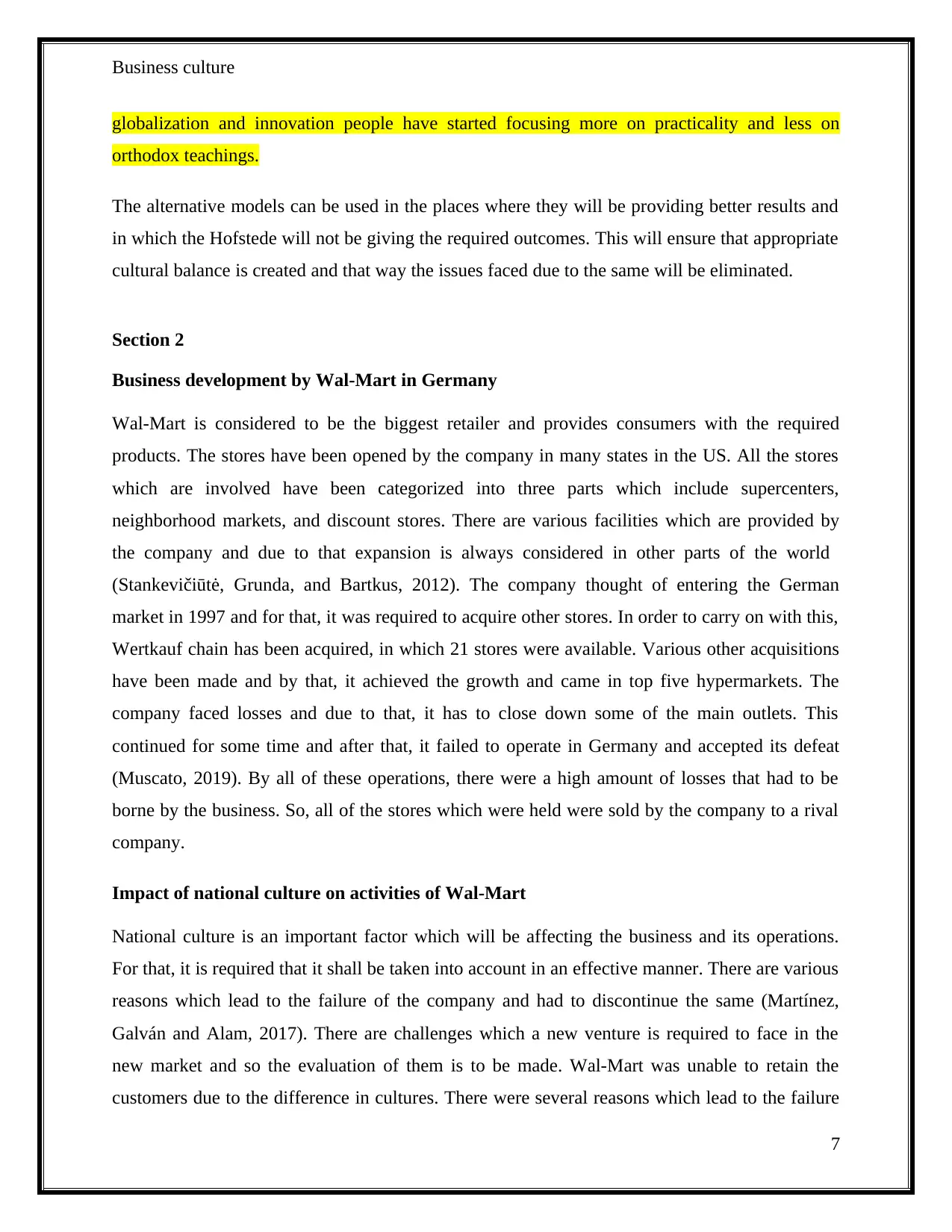
Business culture
globalization and innovation people have started focusing more on practicality and less on
orthodox teachings.
The alternative models can be used in the places where they will be providing better results and
in which the Hofstede will not be giving the required outcomes. This will ensure that appropriate
cultural balance is created and that way the issues faced due to the same will be eliminated.
Section 2
Business development by Wal-Mart in Germany
Wal-Mart is considered to be the biggest retailer and provides consumers with the required
products. The stores have been opened by the company in many states in the US. All the stores
which are involved have been categorized into three parts which include supercenters,
neighborhood markets, and discount stores. There are various facilities which are provided by
the company and due to that expansion is always considered in other parts of the world
(Stankevičiūtė, Grunda, and Bartkus, 2012). The company thought of entering the German
market in 1997 and for that, it was required to acquire other stores. In order to carry on with this,
Wertkauf chain has been acquired, in which 21 stores were available. Various other acquisitions
have been made and by that, it achieved the growth and came in top five hypermarkets. The
company faced losses and due to that, it has to close down some of the main outlets. This
continued for some time and after that, it failed to operate in Germany and accepted its defeat
(Muscato, 2019). By all of these operations, there were a high amount of losses that had to be
borne by the business. So, all of the stores which were held were sold by the company to a rival
company.
Impact of national culture on activities of Wal-Mart
National culture is an important factor which will be affecting the business and its operations.
For that, it is required that it shall be taken into account in an effective manner. There are various
reasons which lead to the failure of the company and had to discontinue the same (Martínez,
Galván and Alam, 2017). There are challenges which a new venture is required to face in the
new market and so the evaluation of them is to be made. Wal-Mart was unable to retain the
customers due to the difference in cultures. There were several reasons which lead to the failure
7
globalization and innovation people have started focusing more on practicality and less on
orthodox teachings.
The alternative models can be used in the places where they will be providing better results and
in which the Hofstede will not be giving the required outcomes. This will ensure that appropriate
cultural balance is created and that way the issues faced due to the same will be eliminated.
Section 2
Business development by Wal-Mart in Germany
Wal-Mart is considered to be the biggest retailer and provides consumers with the required
products. The stores have been opened by the company in many states in the US. All the stores
which are involved have been categorized into three parts which include supercenters,
neighborhood markets, and discount stores. There are various facilities which are provided by
the company and due to that expansion is always considered in other parts of the world
(Stankevičiūtė, Grunda, and Bartkus, 2012). The company thought of entering the German
market in 1997 and for that, it was required to acquire other stores. In order to carry on with this,
Wertkauf chain has been acquired, in which 21 stores were available. Various other acquisitions
have been made and by that, it achieved the growth and came in top five hypermarkets. The
company faced losses and due to that, it has to close down some of the main outlets. This
continued for some time and after that, it failed to operate in Germany and accepted its defeat
(Muscato, 2019). By all of these operations, there were a high amount of losses that had to be
borne by the business. So, all of the stores which were held were sold by the company to a rival
company.
Impact of national culture on activities of Wal-Mart
National culture is an important factor which will be affecting the business and its operations.
For that, it is required that it shall be taken into account in an effective manner. There are various
reasons which lead to the failure of the company and had to discontinue the same (Martínez,
Galván and Alam, 2017). There are challenges which a new venture is required to face in the
new market and so the evaluation of them is to be made. Wal-Mart was unable to retain the
customers due to the difference in cultures. There were several reasons which lead to the failure
7
Paraphrase This Document
Need a fresh take? Get an instant paraphrase of this document with our AI Paraphraser
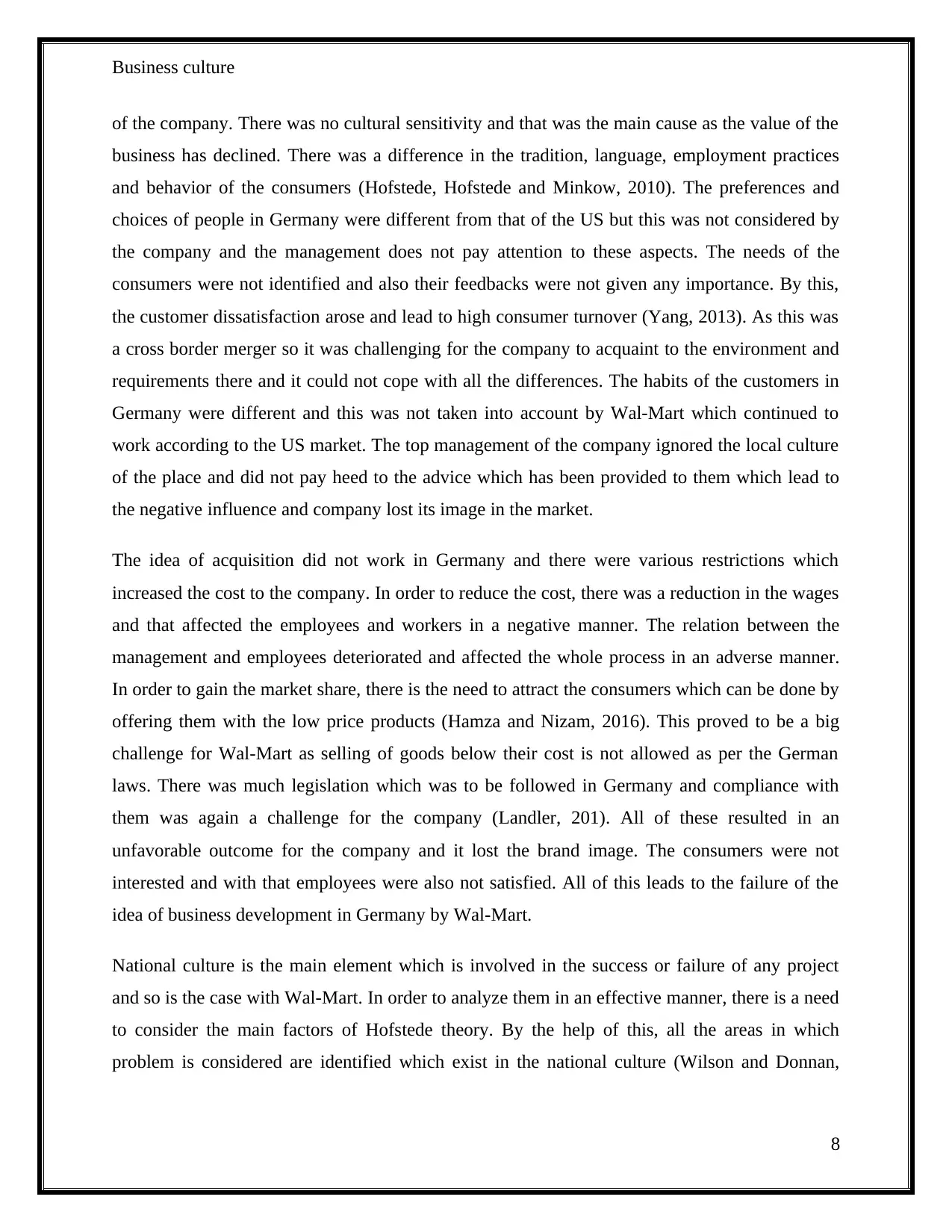
Business culture
of the company. There was no cultural sensitivity and that was the main cause as the value of the
business has declined. There was a difference in the tradition, language, employment practices
and behavior of the consumers (Hofstede, Hofstede and Minkow, 2010). The preferences and
choices of people in Germany were different from that of the US but this was not considered by
the company and the management does not pay attention to these aspects. The needs of the
consumers were not identified and also their feedbacks were not given any importance. By this,
the customer dissatisfaction arose and lead to high consumer turnover (Yang, 2013). As this was
a cross border merger so it was challenging for the company to acquaint to the environment and
requirements there and it could not cope with all the differences. The habits of the customers in
Germany were different and this was not taken into account by Wal-Mart which continued to
work according to the US market. The top management of the company ignored the local culture
of the place and did not pay heed to the advice which has been provided to them which lead to
the negative influence and company lost its image in the market.
The idea of acquisition did not work in Germany and there were various restrictions which
increased the cost to the company. In order to reduce the cost, there was a reduction in the wages
and that affected the employees and workers in a negative manner. The relation between the
management and employees deteriorated and affected the whole process in an adverse manner.
In order to gain the market share, there is the need to attract the consumers which can be done by
offering them with the low price products (Hamza and Nizam, 2016). This proved to be a big
challenge for Wal-Mart as selling of goods below their cost is not allowed as per the German
laws. There was much legislation which was to be followed in Germany and compliance with
them was again a challenge for the company (Landler, 201). All of these resulted in an
unfavorable outcome for the company and it lost the brand image. The consumers were not
interested and with that employees were also not satisfied. All of this leads to the failure of the
idea of business development in Germany by Wal-Mart.
National culture is the main element which is involved in the success or failure of any project
and so is the case with Wal-Mart. In order to analyze them in an effective manner, there is a need
to consider the main factors of Hofstede theory. By the help of this, all the areas in which
problem is considered are identified which exist in the national culture (Wilson and Donnan,
8
of the company. There was no cultural sensitivity and that was the main cause as the value of the
business has declined. There was a difference in the tradition, language, employment practices
and behavior of the consumers (Hofstede, Hofstede and Minkow, 2010). The preferences and
choices of people in Germany were different from that of the US but this was not considered by
the company and the management does not pay attention to these aspects. The needs of the
consumers were not identified and also their feedbacks were not given any importance. By this,
the customer dissatisfaction arose and lead to high consumer turnover (Yang, 2013). As this was
a cross border merger so it was challenging for the company to acquaint to the environment and
requirements there and it could not cope with all the differences. The habits of the customers in
Germany were different and this was not taken into account by Wal-Mart which continued to
work according to the US market. The top management of the company ignored the local culture
of the place and did not pay heed to the advice which has been provided to them which lead to
the negative influence and company lost its image in the market.
The idea of acquisition did not work in Germany and there were various restrictions which
increased the cost to the company. In order to reduce the cost, there was a reduction in the wages
and that affected the employees and workers in a negative manner. The relation between the
management and employees deteriorated and affected the whole process in an adverse manner.
In order to gain the market share, there is the need to attract the consumers which can be done by
offering them with the low price products (Hamza and Nizam, 2016). This proved to be a big
challenge for Wal-Mart as selling of goods below their cost is not allowed as per the German
laws. There was much legislation which was to be followed in Germany and compliance with
them was again a challenge for the company (Landler, 201). All of these resulted in an
unfavorable outcome for the company and it lost the brand image. The consumers were not
interested and with that employees were also not satisfied. All of this leads to the failure of the
idea of business development in Germany by Wal-Mart.
National culture is the main element which is involved in the success or failure of any project
and so is the case with Wal-Mart. In order to analyze them in an effective manner, there is a need
to consider the main factors of Hofstede theory. By the help of this, all the areas in which
problem is considered are identified which exist in the national culture (Wilson and Donnan,
8
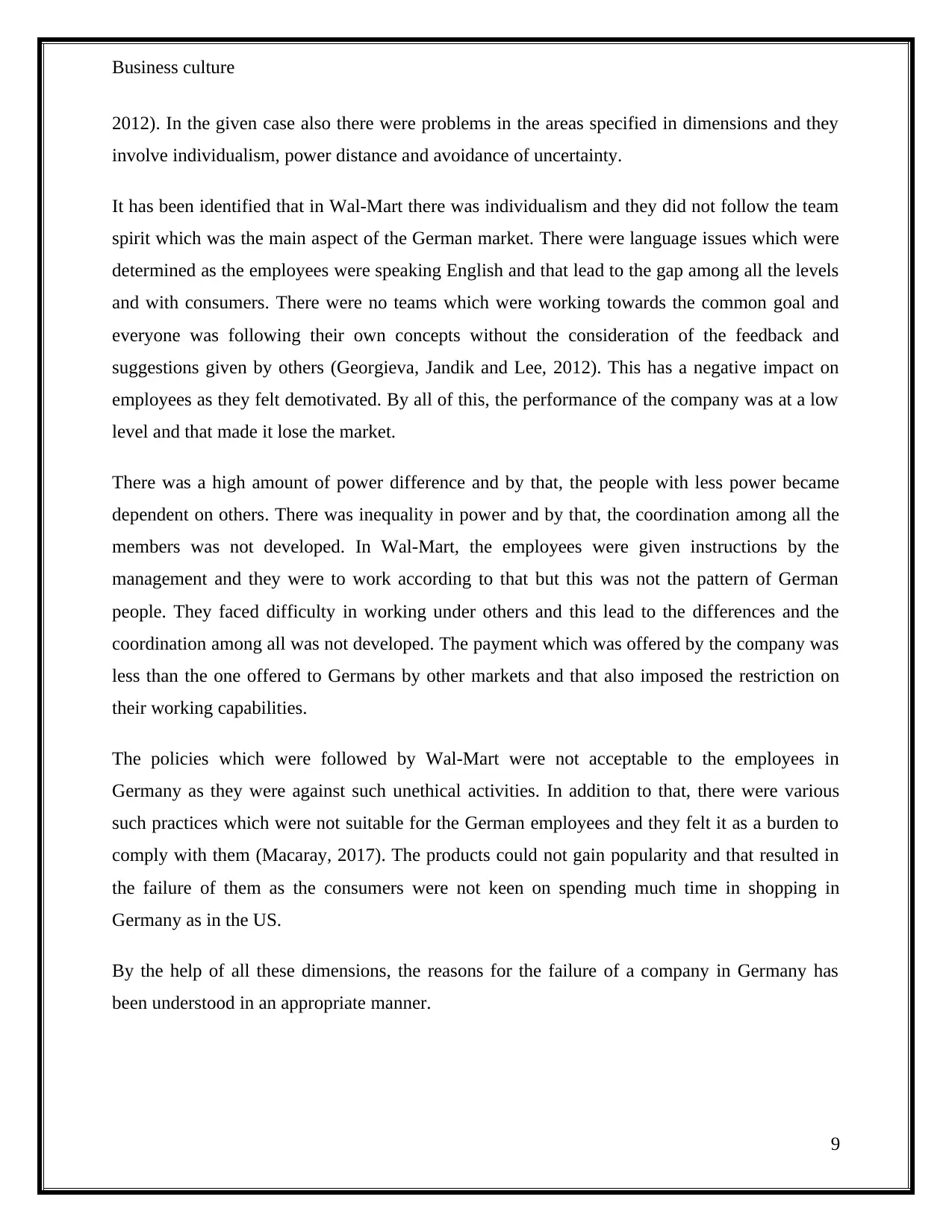
Business culture
2012). In the given case also there were problems in the areas specified in dimensions and they
involve individualism, power distance and avoidance of uncertainty.
It has been identified that in Wal-Mart there was individualism and they did not follow the team
spirit which was the main aspect of the German market. There were language issues which were
determined as the employees were speaking English and that lead to the gap among all the levels
and with consumers. There were no teams which were working towards the common goal and
everyone was following their own concepts without the consideration of the feedback and
suggestions given by others (Georgieva, Jandik and Lee, 2012). This has a negative impact on
employees as they felt demotivated. By all of this, the performance of the company was at a low
level and that made it lose the market.
There was a high amount of power difference and by that, the people with less power became
dependent on others. There was inequality in power and by that, the coordination among all the
members was not developed. In Wal-Mart, the employees were given instructions by the
management and they were to work according to that but this was not the pattern of German
people. They faced difficulty in working under others and this lead to the differences and the
coordination among all was not developed. The payment which was offered by the company was
less than the one offered to Germans by other markets and that also imposed the restriction on
their working capabilities.
The policies which were followed by Wal-Mart were not acceptable to the employees in
Germany as they were against such unethical activities. In addition to that, there were various
such practices which were not suitable for the German employees and they felt it as a burden to
comply with them (Macaray, 2017). The products could not gain popularity and that resulted in
the failure of them as the consumers were not keen on spending much time in shopping in
Germany as in the US.
By the help of all these dimensions, the reasons for the failure of a company in Germany has
been understood in an appropriate manner.
9
2012). In the given case also there were problems in the areas specified in dimensions and they
involve individualism, power distance and avoidance of uncertainty.
It has been identified that in Wal-Mart there was individualism and they did not follow the team
spirit which was the main aspect of the German market. There were language issues which were
determined as the employees were speaking English and that lead to the gap among all the levels
and with consumers. There were no teams which were working towards the common goal and
everyone was following their own concepts without the consideration of the feedback and
suggestions given by others (Georgieva, Jandik and Lee, 2012). This has a negative impact on
employees as they felt demotivated. By all of this, the performance of the company was at a low
level and that made it lose the market.
There was a high amount of power difference and by that, the people with less power became
dependent on others. There was inequality in power and by that, the coordination among all the
members was not developed. In Wal-Mart, the employees were given instructions by the
management and they were to work according to that but this was not the pattern of German
people. They faced difficulty in working under others and this lead to the differences and the
coordination among all was not developed. The payment which was offered by the company was
less than the one offered to Germans by other markets and that also imposed the restriction on
their working capabilities.
The policies which were followed by Wal-Mart were not acceptable to the employees in
Germany as they were against such unethical activities. In addition to that, there were various
such practices which were not suitable for the German employees and they felt it as a burden to
comply with them (Macaray, 2017). The products could not gain popularity and that resulted in
the failure of them as the consumers were not keen on spending much time in shopping in
Germany as in the US.
By the help of all these dimensions, the reasons for the failure of a company in Germany has
been understood in an appropriate manner.
9
⊘ This is a preview!⊘
Do you want full access?
Subscribe today to unlock all pages.

Trusted by 1+ million students worldwide
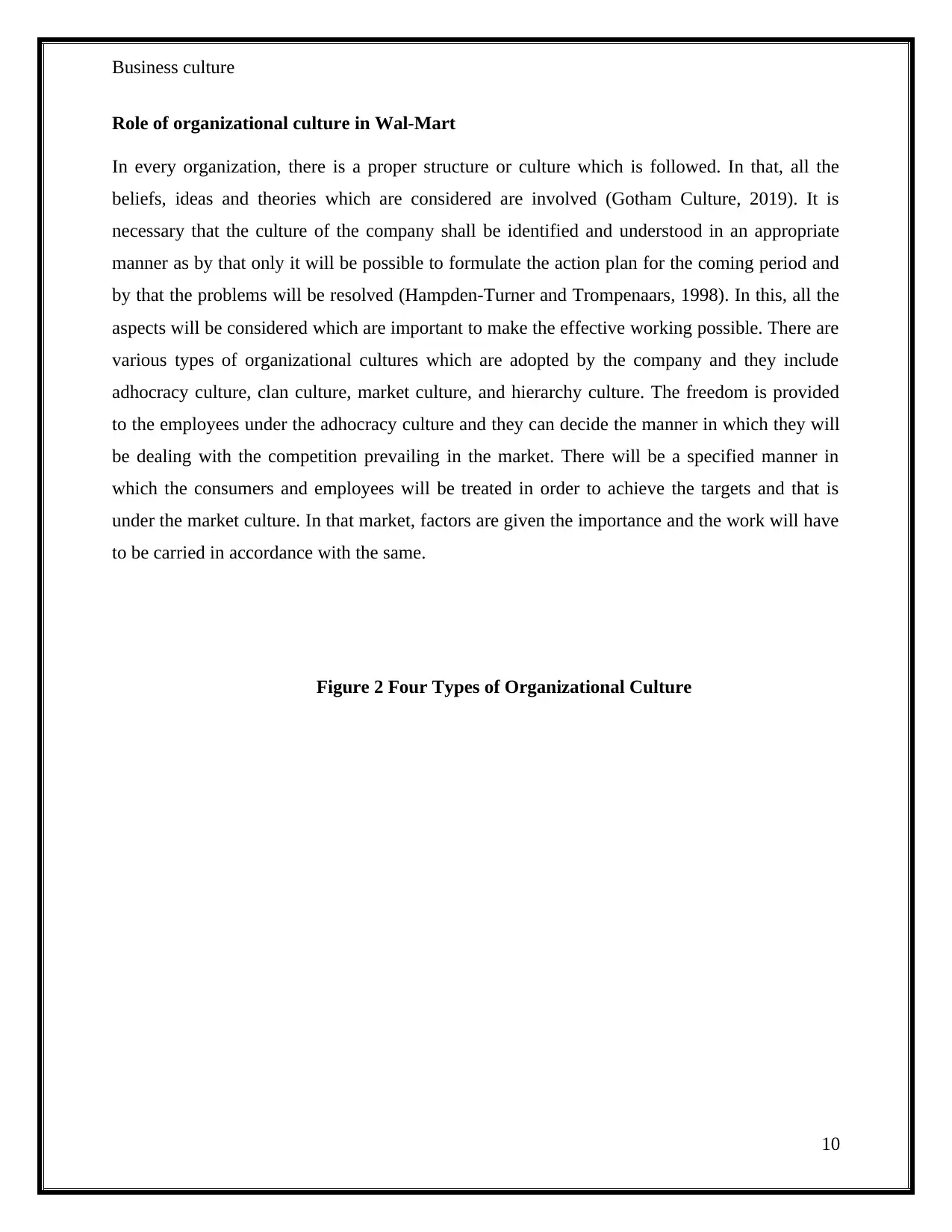
Business culture
Role of organizational culture in Wal-Mart
In every organization, there is a proper structure or culture which is followed. In that, all the
beliefs, ideas and theories which are considered are involved (Gotham Culture, 2019). It is
necessary that the culture of the company shall be identified and understood in an appropriate
manner as by that only it will be possible to formulate the action plan for the coming period and
by that the problems will be resolved (Hampden-Turner and Trompenaars, 1998). In this, all the
aspects will be considered which are important to make the effective working possible. There are
various types of organizational cultures which are adopted by the company and they include
adhocracy culture, clan culture, market culture, and hierarchy culture. The freedom is provided
to the employees under the adhocracy culture and they can decide the manner in which they will
be dealing with the competition prevailing in the market. There will be a specified manner in
which the consumers and employees will be treated in order to achieve the targets and that is
under the market culture. In that market, factors are given the importance and the work will have
to be carried in accordance with the same.
Figure 2 Four Types of Organizational Culture
10
Role of organizational culture in Wal-Mart
In every organization, there is a proper structure or culture which is followed. In that, all the
beliefs, ideas and theories which are considered are involved (Gotham Culture, 2019). It is
necessary that the culture of the company shall be identified and understood in an appropriate
manner as by that only it will be possible to formulate the action plan for the coming period and
by that the problems will be resolved (Hampden-Turner and Trompenaars, 1998). In this, all the
aspects will be considered which are important to make the effective working possible. There are
various types of organizational cultures which are adopted by the company and they include
adhocracy culture, clan culture, market culture, and hierarchy culture. The freedom is provided
to the employees under the adhocracy culture and they can decide the manner in which they will
be dealing with the competition prevailing in the market. There will be a specified manner in
which the consumers and employees will be treated in order to achieve the targets and that is
under the market culture. In that market, factors are given the importance and the work will have
to be carried in accordance with the same.
Figure 2 Four Types of Organizational Culture
10
Paraphrase This Document
Need a fresh take? Get an instant paraphrase of this document with our AI Paraphraser

Business culture
(Source: POPin, 2019)
In this figure the various types of organizational cultures which are present have been
determined. The basic features in relation each culture is also described for the quick and better
understanding.
Talking about the organizational culture inventory, it should be noted that this tool helps in
measuring performance of the business. It helps in evaluating the attributes of culture that affect
the behavior and performance of people in an organization. This segment helps in analyzing the
gaps present in the culture of an organization that are needed to change. Organizational culture
plays the most important role in success or failure of an organization. Culture helps the
management in motivating the people; it also helps in creating a positive business environment
with effective communication. Culture of an organization can demotivate the employees and
spread negative rumors about top management that can subsequently decrease the employee
retention rate in the organization and vice versa. The OCI will help the organization in
identifying the flaws in their system and working on them effectively to attain peace in the
internal environment of the organization.
11
(Source: POPin, 2019)
In this figure the various types of organizational cultures which are present have been
determined. The basic features in relation each culture is also described for the quick and better
understanding.
Talking about the organizational culture inventory, it should be noted that this tool helps in
measuring performance of the business. It helps in evaluating the attributes of culture that affect
the behavior and performance of people in an organization. This segment helps in analyzing the
gaps present in the culture of an organization that are needed to change. Organizational culture
plays the most important role in success or failure of an organization. Culture helps the
management in motivating the people; it also helps in creating a positive business environment
with effective communication. Culture of an organization can demotivate the employees and
spread negative rumors about top management that can subsequently decrease the employee
retention rate in the organization and vice versa. The OCI will help the organization in
identifying the flaws in their system and working on them effectively to attain peace in the
internal environment of the organization.
11
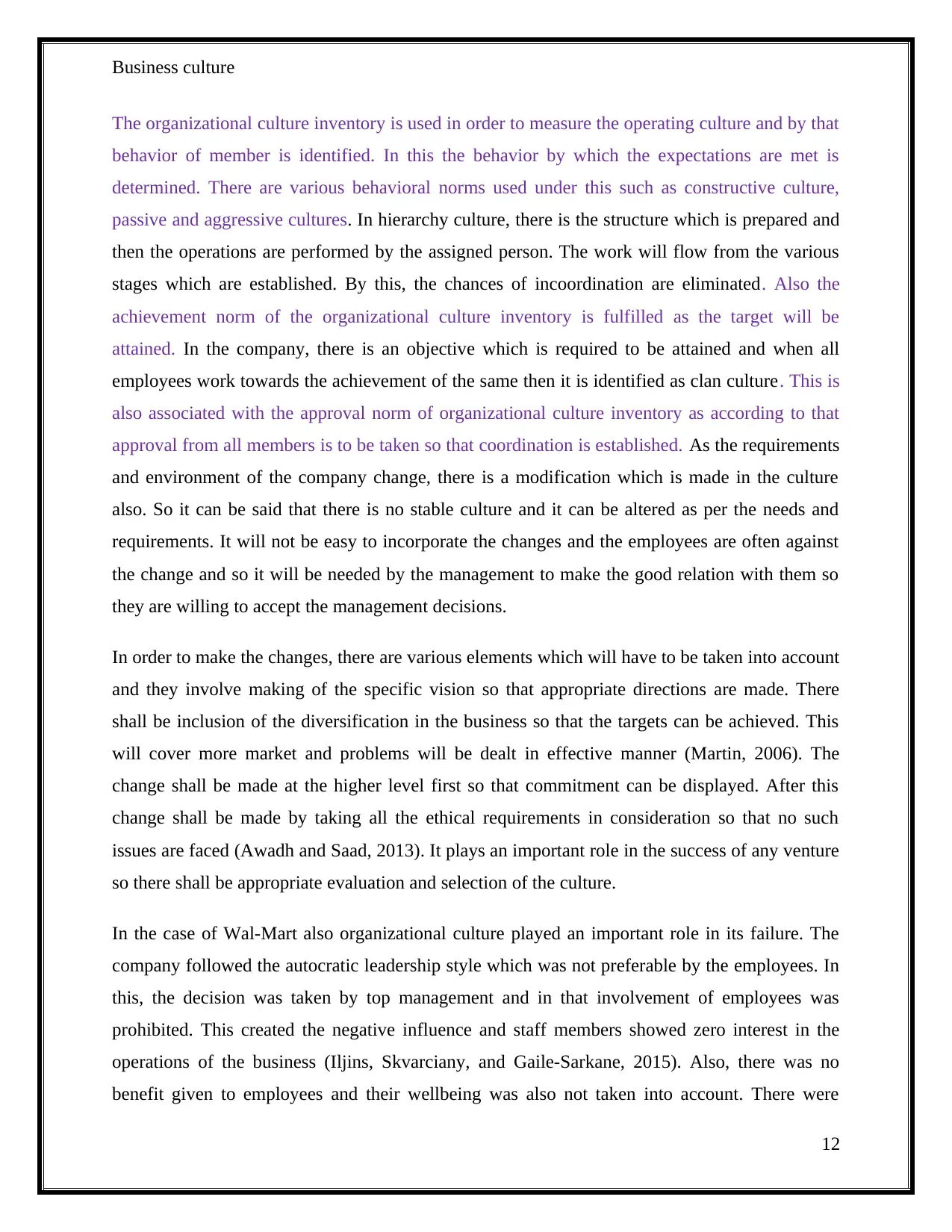
Business culture
The organizational culture inventory is used in order to measure the operating culture and by that
behavior of member is identified. In this the behavior by which the expectations are met is
determined. There are various behavioral norms used under this such as constructive culture,
passive and aggressive cultures. In hierarchy culture, there is the structure which is prepared and
then the operations are performed by the assigned person. The work will flow from the various
stages which are established. By this, the chances of incoordination are eliminated. Also the
achievement norm of the organizational culture inventory is fulfilled as the target will be
attained. In the company, there is an objective which is required to be attained and when all
employees work towards the achievement of the same then it is identified as clan culture. This is
also associated with the approval norm of organizational culture inventory as according to that
approval from all members is to be taken so that coordination is established. As the requirements
and environment of the company change, there is a modification which is made in the culture
also. So it can be said that there is no stable culture and it can be altered as per the needs and
requirements. It will not be easy to incorporate the changes and the employees are often against
the change and so it will be needed by the management to make the good relation with them so
they are willing to accept the management decisions.
In order to make the changes, there are various elements which will have to be taken into account
and they involve making of the specific vision so that appropriate directions are made. There
shall be inclusion of the diversification in the business so that the targets can be achieved. This
will cover more market and problems will be dealt in effective manner (Martin, 2006). The
change shall be made at the higher level first so that commitment can be displayed. After this
change shall be made by taking all the ethical requirements in consideration so that no such
issues are faced (Awadh and Saad, 2013). It plays an important role in the success of any venture
so there shall be appropriate evaluation and selection of the culture.
In the case of Wal-Mart also organizational culture played an important role in its failure. The
company followed the autocratic leadership style which was not preferable by the employees. In
this, the decision was taken by top management and in that involvement of employees was
prohibited. This created the negative influence and staff members showed zero interest in the
operations of the business (Iljins, Skvarciany, and Gaile-Sarkane, 2015). Also, there was no
benefit given to employees and their wellbeing was also not taken into account. There were
12
The organizational culture inventory is used in order to measure the operating culture and by that
behavior of member is identified. In this the behavior by which the expectations are met is
determined. There are various behavioral norms used under this such as constructive culture,
passive and aggressive cultures. In hierarchy culture, there is the structure which is prepared and
then the operations are performed by the assigned person. The work will flow from the various
stages which are established. By this, the chances of incoordination are eliminated. Also the
achievement norm of the organizational culture inventory is fulfilled as the target will be
attained. In the company, there is an objective which is required to be attained and when all
employees work towards the achievement of the same then it is identified as clan culture. This is
also associated with the approval norm of organizational culture inventory as according to that
approval from all members is to be taken so that coordination is established. As the requirements
and environment of the company change, there is a modification which is made in the culture
also. So it can be said that there is no stable culture and it can be altered as per the needs and
requirements. It will not be easy to incorporate the changes and the employees are often against
the change and so it will be needed by the management to make the good relation with them so
they are willing to accept the management decisions.
In order to make the changes, there are various elements which will have to be taken into account
and they involve making of the specific vision so that appropriate directions are made. There
shall be inclusion of the diversification in the business so that the targets can be achieved. This
will cover more market and problems will be dealt in effective manner (Martin, 2006). The
change shall be made at the higher level first so that commitment can be displayed. After this
change shall be made by taking all the ethical requirements in consideration so that no such
issues are faced (Awadh and Saad, 2013). It plays an important role in the success of any venture
so there shall be appropriate evaluation and selection of the culture.
In the case of Wal-Mart also organizational culture played an important role in its failure. The
company followed the autocratic leadership style which was not preferable by the employees. In
this, the decision was taken by top management and in that involvement of employees was
prohibited. This created the negative influence and staff members showed zero interest in the
operations of the business (Iljins, Skvarciany, and Gaile-Sarkane, 2015). Also, there was no
benefit given to employees and their wellbeing was also not taken into account. There were
12
⊘ This is a preview!⊘
Do you want full access?
Subscribe today to unlock all pages.

Trusted by 1+ million students worldwide
1 out of 17
Related Documents
Your All-in-One AI-Powered Toolkit for Academic Success.
+13062052269
info@desklib.com
Available 24*7 on WhatsApp / Email
![[object Object]](/_next/static/media/star-bottom.7253800d.svg)
Unlock your academic potential
Copyright © 2020–2025 A2Z Services. All Rights Reserved. Developed and managed by ZUCOL.





